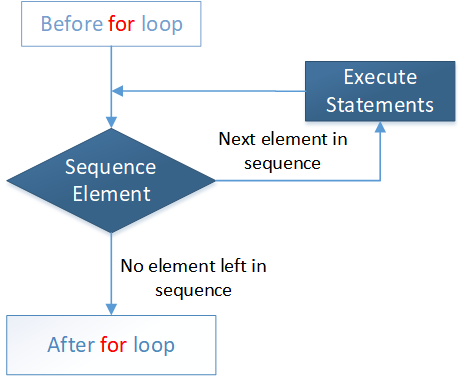Python - For Loop
The for loop
The for loop in Python is used to iterate over a given sequence and executes a set of statements for each element in the sequence. A sequence can be any data structure like list, tuple, set, string, dictionary and range iterables etc.
Syntax
for iterating_var in sequence:
statements
Flow Diagram:

For loop over a range:
In the example below, for loop is used over a given range.
print("#Result 1:")
for i in range(4):
print(i, i * 2)
print("\n#Result 2:")
for j in range(2, 6):
print(j, j ** 2)
print("\n#Result 3:")
for k in range(10, 2, -2):
print(k)
The output of the above code will be:
#Result 1: 0 0 1 2 2 4 3 6 #Result 2: 2 4 3 9 4 16 5 25 #Result 3: 10 8 6 4
For loop over List
In the example below, for loop is used over a list to access its elements.
colors = ['Red', 'Blue', 'Green'] for x in colors: print(x)
The output of the above code will be:
Red Blue Green
For loop over Tuple
In the example below, for loop is used over a tuple to access its elements.
days = ('Monday', 'Tuesday', 'Wednesday', 'Thursday', 'Friday', 'Saturday', 'Sunday')
for day in days:
print(day)
The output of the above code will be:
Monday Tuesday Wednesday Thursday Friday Saturday Sunday
For loop over Set
The example below describes how to use a for loop over a set to access its elements.
numbers = {100, 200, 300, 400, 500}
for i in numbers:
print(i)
The output of the above code will be:
400 100 500 200 300
For loop over String
As discussed earlier, a for loop can be used to access characters of a given string.
word = 'python' for letter in word: print(letter)
The output of the above code will be:
p y t h o n
For loop over Dictionary
In the same way, a for loop can be used to access key-value pairs of a given dictionary.
dict = {
'year': '2000',
'month': 'March',
'date': 15
}
print("#Result 1:")
for day in dict:
print(day)
print("\n#Result 2:")
for day, value in dict.items():
print(day,value)
The output of the above code will be:
#Result 1: year month date #Result 2: year 2000 month March date 15


